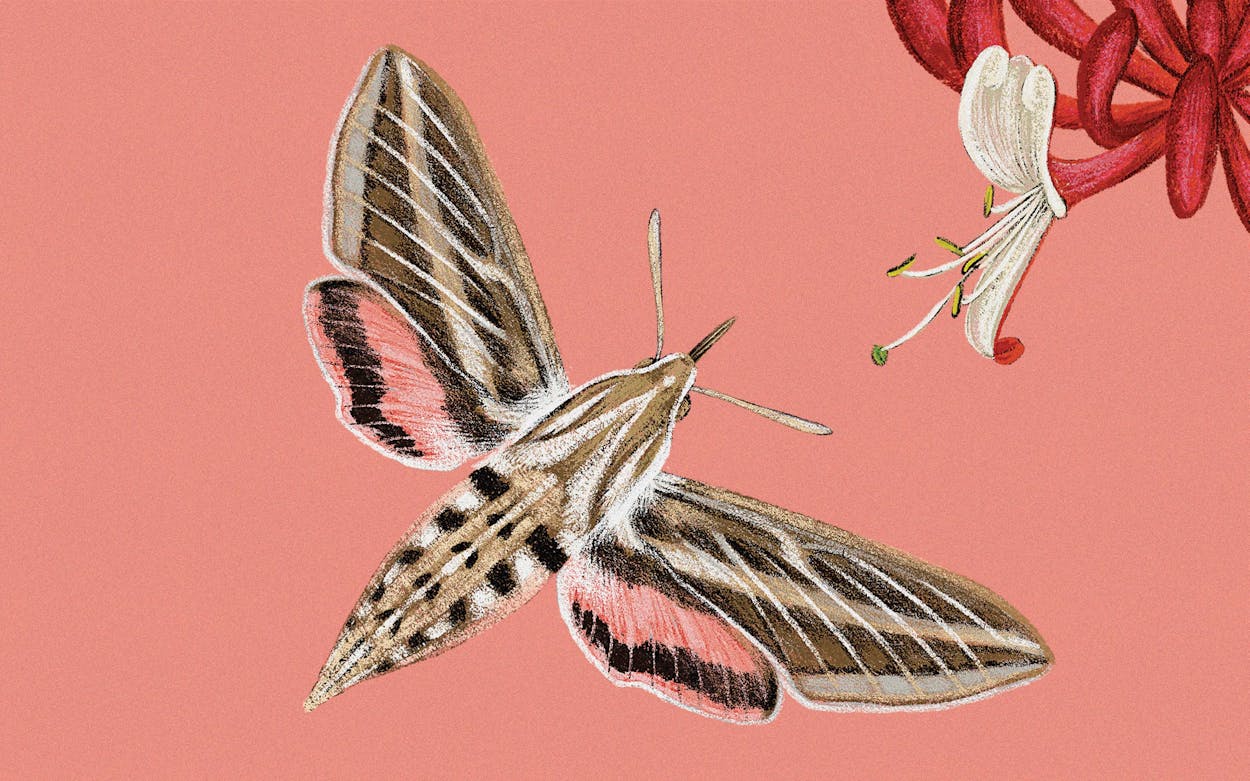Latin name: Hyles lineata
Size: Two-to three-inch wingspan
Habitat: Statewide
Jewel-toned wings gleam in the sun as this bauble of a bug flits from flower to flower. Fast and furious wingbeats, as many as seventy per second, produce an audible hum as it hovers, sipping nectar. Unless you catch a rare glimpse of this insect at rest, you’ll probably think it’s a tiny bird, which is why folks often call it a hummingbird moth. Others refer to it as a hawk moth, but it’s officially known as the white-lined sphinx. The moth is one of the prettiest and most widespread of the more than 1,450 species belonging to the sphinx family—and one of the likeliest to appear in Texas yards.
How do I distinguish it from a hummingbird?
Check for antennae on the head. If you see them, you’re looking at an insect. Another telltale sign: six legs, as opposed to two. And instead of a needle-shaped beak, a hummingbird moth boasts a long proboscis through which to slurp that sweet, sweet nectar. These differences may sound obvious, but they can be tough to spot, since both creatures usually appear as a blur.
I’d love to lure one to my yard. Any tips?
“They gravitate toward trumpet-style flowers,” such as honeysuckle and jimsonweed, says Marianna Treviño-Wright, the executive director of the National Butterfly Center, in Mission, just southwest of McAllen. She’s also spotted the moths on Texas thistle and laments that some gardeners view the prickly purple flower—a vital food source for many pollinators—as a weed to be eradicated. “Let it grow,” she says.
What’s its life cycle like?
Funky! The lime-green caterpillar form is called a hornworm. It doesn’t bite or sting, but its spiky horn sure looks scary to predators. Many gardeners consider them pests, because they devour tomato leaves. (Treviño-Wright’s advice is, again, to let nature do its thing: your tomato plant will grow back.) When it’s time to transform, the hornworm weaves a cocoon around itself, usually under leaf litter. “It looks like a turd,” Treviño-Wright says. “So if you don’t know that, and when you clean up”—as with a leaf blower—“you’re getting rid of hummingbird moths.” All together now: let it grow!
I thought moths were active only at night. You know, moth to a flame and all that?
Most moths do prefer to fly in the dark, but there are many day species as well. The adaptable hummingbird moth will feed most any hour. You’re most likely to see them in summer, when lots of flowers are blooming. They live for about ten to thirty days, which sounds fleeting to us but is a ripe old age for a moth.
An abbreviated version of this article originally appeared in the April issue of Texas Monthly with the headline “Hummingbird Moth.” Subscribe today.
- More About:
- Critters









